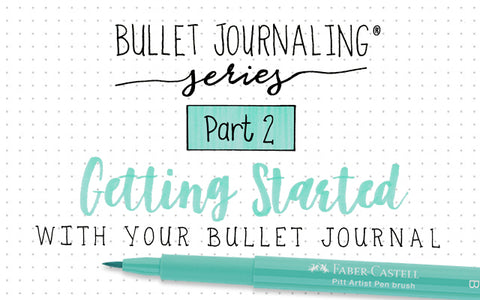Bullet Journaling® Series Part 3: Creating Collections

Bullet Journaling Framework!
When learning how to Bullet Journal®, an overload of different information and ideas will be thrown your way. Though inspired you may feel overwhelmed. Do not get discouraged, we at Faber-Castell are here to break it down for you. In this article, we are mastering how to create and manage your Bullet Journal Collections. Bullet Journaling is personal, so feel free to get as creative as your inspiration takes you while still following the framework of Bullet Journal inventor Ryder Carroll.
Bullet Journal Collections are what Carroll calls the framework of your journal; how your different notes, tasks, events, or thoughts are kept organized. Collections are customizable. A collection can be your mood tracker, your budget, or your goals. Before you get to that step; however, let’s learn about the four core collections: Then Index, Future Log, Monthly Log, and the Daily Log.
The Index:
The index is a crucial component to the organization of your Bullet Journal; it is the bind of the journal. Here you keep track of where your collections live in your journal. Simply list the name of your collection followed by their page numbers. Make sure to number your journal pages if not already numbered.
The Daily Log:
The daily log is where you will record everything occurring in
your daily life. Organize the chaos through a process called rapid logging. Log and identify your tasks with a simple dot bullet, events with a circular open bullet, and notes by a dash bullet.
(To take a deeper dive into rapid logging by visiting our Bullet Journal Series article covering tools and techniques.)
The Monthly Log:
Things get a little more complex as you form the monthly log. Your monthly log should consist of a calendar page and a task page.
This calendar is different than the standard we are used to using in planners and journals. Create the calendar by numbering the days of the month down your left margin, with the first letter of the day of the week next to it. Here you can briefly record your tasks and events. The simple design of the monthly calendar dismisses all the clutter and lets you focus on what is to come in the next month.
Your task page is meant for you to pour all important current or lingering tasks into one list. Have that dreaded presentation due in three weeks or a big party to prepare for? Get the anticipation out of your head and onto the page. The Monthly Log is important because it gives you a chance to reflect and plan how you will tackle upcoming tasks or events.
The Future Log:
The future log allows a little more freedom to format the way you want. List the upcoming months to give yourself a visual of what is yet to come. Some organize their future log with a preview of the full year, where others may do a six-month preview. This can help you get ahead and prevent tasks from sneaking up on you. List the name of the month followed by dates that have tasks or events. Be sure to look back on months as they go by to see if anything needs to be migrated into another log.

Customized Collections:
Collections don’t stop there. Anything relevant to your life can be made into a collection. Create a collection to track your goals for the year or budget for that new car you want. No matter the topic, there is a way to make it into a collection. In our next article, we are getting creative! Stay tuned as we uncover customized collections and provide some inspiration on personalizing your Bullet Journal.

Want to learn more? Continue reading our Bullet Journaling Series!
 |
 |
| Bullet Journaling Series Part 1: Introduction to Bullet Journaling |

